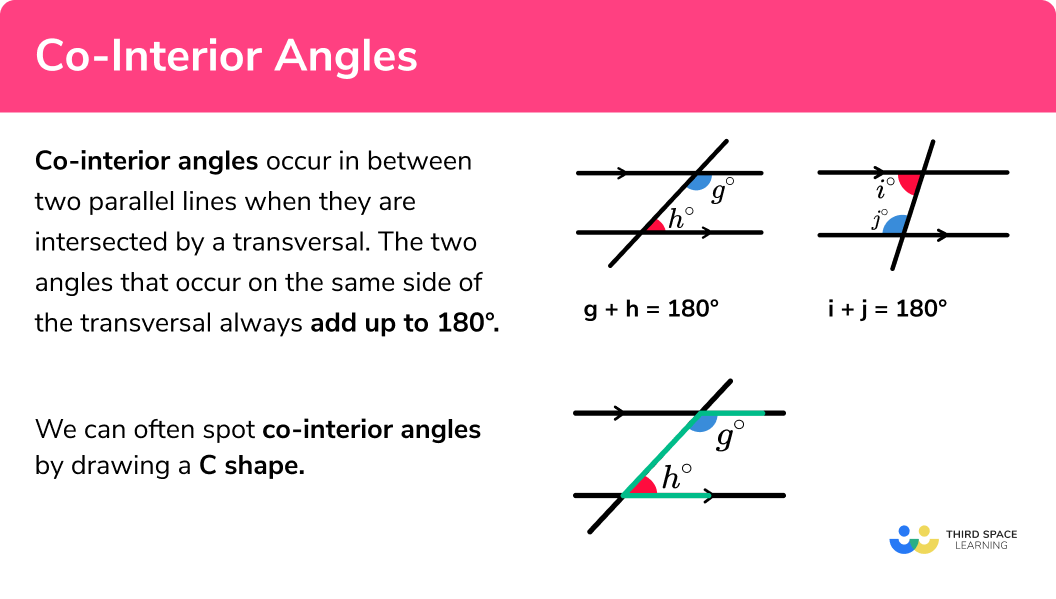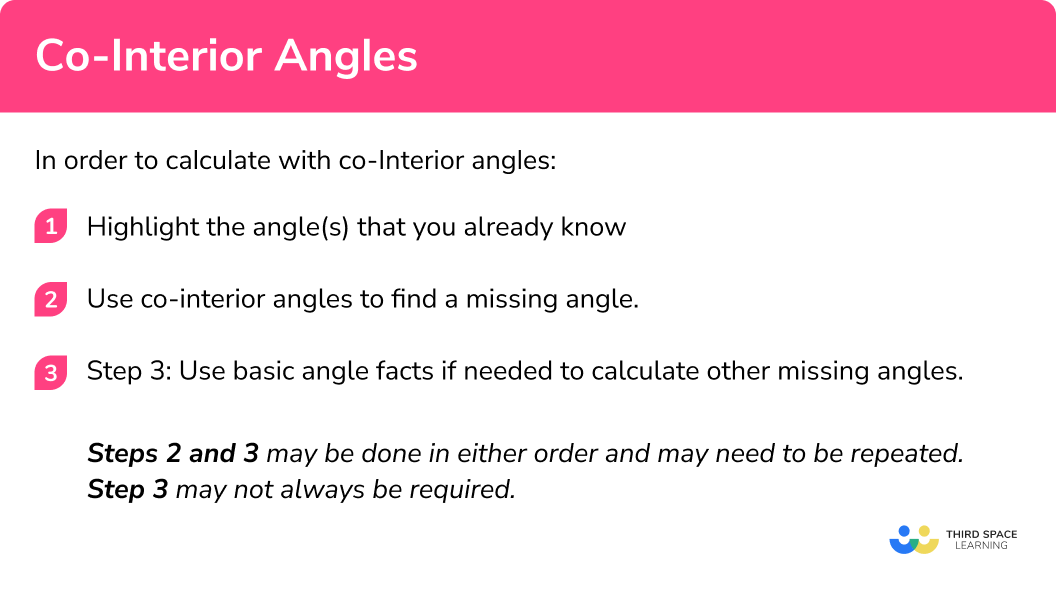GCSE Tutoring Programme
Our chosen students improved 1.19 of a grade on average - 0.45 more than those who didn't have the tutoring.
In order to access this I need to be confident with:
Angle rules Angles in a triangle Angles in polygons Solving equationsThis topic is relevant for:

Co-Interior Angles
Here we will learn about co-interior angles in parallel lines, including how to recognise co-interior angles, and apply this understanding to solve problems.
There are also angles in parallel lines worksheets based on Edexcel, AQA and OCR exam questions, along with further guidance on where to go next if you’re still stuck.
What are co-interior angles?
Co-interior angles in parallel lines occur in between two parallel lines when they are intersected by a transversal. The two angles that occur on the same side of the transversal always add up to
Co-interior angles add up to
We can often spot co-interior angles by drawing a
The two interior angles are only equal when they are both 90º.
In all other cases we can work out one of the co-interior angles by subtracting the other from
What are co-interior angles?

How to calculate with co-interior angles
In order to find a missing angle in parallel lines:
- Highlight the angle(s) that you already know.
- Use co-interior angles to find a missing angle.
- Use basic angle facts to calculate the missing angle.
Steps
Explain how to calculate with co-interior angles


Co-interior angles worksheet

Get your free co-interior angles worksheet of 20+ questions and answers. Includes reasoning and applied questions.
DOWNLOAD FREE
Co-interior angles worksheet

Get your free co-interior angles worksheet of 20+ questions and answers. Includes reasoning and applied questions.
DOWNLOAD FREEAngles in parallel lines – co-interior angles examples
Example 1: co-interior angles
Calculate the size of the missing angle
- Highlight the angle(s) that you already know.
2Use co-interior angles to find a missing angle.
Here we can label the co-interior angle on the diagram as
3Use a basic angle fact to calculate the missing angle.
Here as
Example 2: co-interior angles
Calculate the size of the missing angle
Highlight the angle(s) that you already know.
Here we can use either the
Use co-interior angles to find a missing angle.
As co-interior angles have a sum of
Use a basic angle fact to calculate the missing angle.
Here we have a trapezium with the sum of interior angles as
Example 3: co-interior angles with algebra
Calculate the size of the missing angle
Highlight the angle(s) that you already know.
We need to find the value of
Use co-interior angles to find a missing angle.
As
This gives us the two co-interior angles of
Use a basic angle fact to calculate the missing angle.
The angles in the triangle are
Since \theta and 42^o are on a straight line,
Common misconceptions
- Mixing up angle facts
There are a lot of angle facts and it is easy to mistake alternate angles with corresponding angles. To prevent this from occurring, think about co-interior angles being inside the
- Using a protractor to measure an angle
Using a protractor to measure an angle. Most diagrams are not to scale and so using a protractor will not result in a correct answer unless it is a coincidence.
Related lessons
Co-interior angles is part of our series of lessons to support revision on angles in parallel lines. You may find it helpful to start with the main angles in parallel lines lesson for a summary of what to expect, or use the step by step guides below for further detail on individual topics. Other lessons in this series include:
Practice co-interior angles questions
1. Calculate the value of \theta. Justify your answer




\theta and 44^{\circ} are co-interior angles. Therefore,
\theta = 180-44=136^{\circ}
2. Calculate the value of \theta




Using co-interior angles, we can calculate
180-125=55^{\circ}
Using co-interior angles again, we can see that
\theta=180-55=125^{\circ}
3. Given the information in the diagram, calculate the size of angle \theta




Using co-interior angles, we can calculate
180-110=70^{\circ}
Since it is an isosceles triangle, the other angle at the bottom of the triangle is 70^{\circ} as well.
Then, using angles in a triangle,
\theta=180-(70+70)=40^{\circ}
4. Calculate the value of \theta




(7 + \theta)^{\circ} and 88^{\circ} are co-interior angles therefore
\begin{aligned} (7+ \theta) +88&=180\\\\ \theta&=180-(88+7)\\\\ \theta&=85^{\circ} \end{aligned}
5. Work out the value of \theta




Since the triangle is an isosceles triangle, we know that the other angle at the top of the triangle is 68^{\circ}.
(\theta+68)^{\circ} and 68^{\circ} are co-interior angles therefore
(\theta+68) + 68 = 100 \theta = 180-(68+68) \theta=44\degree
6. By calculating the value for x , work out the size of each angle labelled.
42^{\circ} and 38^{\circ}

30^{\circ} and 30^{\circ}

80^{\circ} and 100^{\circ}

78^{\circ} and 102^{\circ}

3x+12 and 2x+18 are co-interior angles, and so add up to 180\degree.
Therefore, we can write
3x+12+2x+18=180
5x+30=180
5x=150
x=30
so
3x+12=3 \times 30 + 12=102\degree
2x+18=2 \times 30+18=78\degree
Co-interior angles GCSE questions
1.
(a) Find the size of angle x .
(b) Find the size of angle y .
(3 marks)
(a)
180-38=142^{\circ} as co-inteior angles add to 180^{\circ}
180-142=38^{\circ} as angles on a straight line add to 180^{\circ}
(2)
(b)
180 – {(110 + 38)}=32^{\circ}
(1)
2. Work out the value of x .
(3 marks)
5x – 7 + 3x + 11 = 180
(1)
8x + 4 = 180
(1)
x=22^{\circ}
(1)
3. Are the lines AB and CD parallel? Give a reason for your answer.
(2 marks)
No,
95+87=182^{\circ}
(1)
When two lines are parallel, the co-interior angles add up to 180^{\circ}
(1)
Learning checklist:
You have now learned how to:
-
Apply the properties of angles at a point, angles at a point on a straight line, vertically opposite angles
-
Understand and use the relationship between parallel lines and alternate and corresponding angles
The next lessons are
Still stuck?
Prepare your KS4 students for maths GCSEs success with Third Space Learning. Weekly online one to one GCSE maths revision lessons delivered by expert maths tutors.

Find out more about our GCSE maths tuition programme.